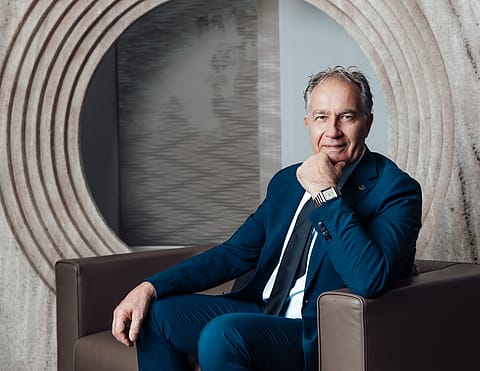Rado clocks double-digit growth in India, eyes long-term luxury boom
The Swiss luxury watchmaker maintains double-digit growth in India despite global disruptions

For Rado, India isn’t just another market, it’s a growth engine. The Swiss luxury watchmaker has been recording double-digit growth here every year, even through global disruptions like the pandemic and geo-political turbulence. “Every year we were capable to realise a two-digit growth in the Indian market,” said Adrian Bosshard, global CEO of Rado. “In such a big market, it shows that our brand and products are particularly appreciated.”
The festive season is when that appreciation turns visible. Diwali, followed by the wedding season, is Rado’s busiest time in India. “It’s without a doubt a very important period for the whole watch industry in India,” Bosshard said. “Gifting during this time is not just short-term gifting, it’s long-term, often within families or friendships. People want something that lasts.”
To capture that sentiment, Rado doubles down on communication and product focus around this period. Campaigns with brand ambassadors Katrina Kaif and Hrithik Roshan are crafted to “celebrate twice this specific period of the year,” he added, with an emotional appeal and special-edition watches. Watches with diamonds, in particular, see a sharp spike in sales. “Diamond watches are requested all year, but Diwali brings a particular peak,” he said.
Rado experiences a two-digit increase in demand during this quarter compared with other periods.
Bosshard credits Rado’s success in India to one simple principle - value for money. “The Indian customer is ready to spend but only when he’s convinced he gets maximum value,” he explained. “Our products are made with high-tech ceramic, the most noble material in Swiss watchmaking - it’s light, scratch-resistant, and has a luxurious feel. When an Indian customer puts ₹1–4 lakh on the table, he has big expectations. We are proud that we can meet them.”
A maturing luxury buyer
The Rado chief believes India’s luxury perception has evolved significantly over the past few years. Millennials and Gen Z buyers are driving a shift where watches are seen not as time-telling tools but as statements of personal style. “Nobody needs a watch to know the time anymore,” he said. “Today, a watch is an artwork, a personal commitment to what you wear on your wrist.”
This emotional connection, combined with India’s appetite for both luxury and practicality, makes the market unique. “The customer needs both, a premium and luxury perception, and the real value of the product in terms of movement and material,” he said. That balance, he believes, is what keeps Rado “unbeatable in value for money.”
Recommended Stories
Smaller cities are also joining the luxury story. “Tier-2, Tier-3, and Tier-4 cities are growing, both in physical stores and e-commerce,” he said. “E-commerce for us is complementary. We use it to reach customers who don’t have a nearby Rado store, but brick-and-mortar will remain our priority.” The company is also planning a dedicated e-commerce platform in India soon.
Rado’s relationship with India stretches back six decades, but the past two decades have seen especially strong growth. “We’ve been present for over 50–60 years and very intensely in the last 20,” Bosshard said. “In the ₹1–4 lakh range, we are by far the strongest brand in the country.” He attributes that to long-standing local partnerships and leadership continuity.
The company currently operates 34 mono-brand boutiques in India and works with a large network of independent retailers, many second or third-generation. While Rado hasn’t expanded its distribution footprint in quantity in last two years, it has improved quality. “Customers today appreciate walking into a Rado boutique where they can experience the full brand world,” Bosshard said.
Globally, Rado operates in over 80 countries. Despite geopolitical challenges and currency fluctuations, the company remains on a “positive growing level” in Swiss francs, even after adjusting for the strong currency. “India has contributed a lot to our global growth this year - a high double-digit contribution,” Bosshard said.
India is contributing “a bit more, let’s put it that way” he said without revealing any specific numbers.
Looking ahead
Bosshard’s optimism for India stands out, but his reading of the global luxury market is nuanced. “We are a global brand and we see that countries are in different situations,” he said. “China, from 2000 until 2024, was the continent with the most spectacular growth. But since two years, it’s in a more challenging situation, though it will come back.”
The US, he said, is performing “very, very strongly” despite the tax situation, with Canada and Mexico also on an upward trend. “Europe is more stable, it’s a fight for market share now. The German car industry is a bit challenged, and when that happens, the overall economy feels the impact,” he explained. Australia, meanwhile, is performing well, and the Middle East is seeing some recovery after the geopolitical challenges of recent years.
But it’s India that gives him the strongest sense of déjà vu. “When I first came to India in 2021, it reminded me of China in 2003,” Bosshard said. “A huge country with a young, ambitious, well-educated population, that’s the best foundation for future luxury consumers. People first want a home, then furniture, and then they start dreaming of luxury. Rado is an important brand in that aspiration.”
He sees no slowdown ahead. “The real growth has just started,” Bosshard said. “India’s young generation will earn well, aspire more, and that’s where the opportunity lies. With over 1.34 billion people and a rising middle class, we still have a lot of customers to enjoy the beauty of our products.”
He is absolutely convinced that for the next years, and even decades, the opportunities here will only grow.